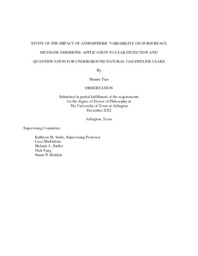| dc.description.abstract | Natural gas (NG), taken as a bridging fuel for achieving a low-carbon future, has rapidly grown to be a significant component of the global energy system and requires extensive pipeline infrastructures, most of them buried underground. Fugitive methane (CH4) emissions from NG pipeline leaks pose environmental, safety, and economic threats to the public. An effective leak detection and quantification (LDAQ) survey method is critical to identifying a leak and assessing the size when it has occurred, thus initiating appropriate response actions to repair it and accounting for the environmental risks accurately. However, gaps exist between LDAQ survey methods, and the effectiveness remains unclear. This doctoral study focuses on bridging such gaps that currently exist within the scientific, industrial, and policy-making communities by investigating 1) how atmospheric variability affects subsurface NG emissions and 2) how we can account for this understanding in LDAQ survey methods. Specifically, three phases are defined. First, this study systematically analyzed the influences of atmospheric variability and survey parameters on the detection probability (DP) of LDAQ surveys. A validated DP model was developed that incorporates the leak rate, survey distance, survey speed, atmospheric stability, wind speed, and air temperature. Results demonstrate that DP is highly impacted by survey speed, atmospheric stability, and wind speed. The options of favorable weather conditions to have a high DP (e.g., >50%) decrease rapidly with the increase in survey speed. Next, the atmospheric dispersion inverse modeling method was used to investigate the subsurface CH4 emissions and quantify the emission estimate accuracy against the known controlled NG release rates. Results show the large temporal variability of CH4 emissions from NG pipeline leaks. At least 6 h of data is needed to have an emission estimate accuracy within ±27% of the controlled release rate on average. With 1 h of data, the probability that the emission estimate is within ±50% of the controlled release rate (P±50%) is 50%, but it approaches 100% when 3–4 h of data is collected. Finally, atmospheric CH4 plume shape and size were characterized to provide a physical base for designing or using the survey parameters. Results demonstrate that survey parameters (i.e., survey speed, and height) are significantly affected by atmospheric stability, wind speed, and air humidity driving the plume variability. The maximum survey speed is about 25 mph in Pasquill–Gifford (PG) stability A (Extremely unstable conditions), but it reduces to 16 mph in PG G (Extremely stable conditions). Leak survey typically has a large range of survey speed options (0–25 mph) at 5 m above the ground under unstable (PG A to B/C), calm to medium speed (0–3 m s-1), and high to very high (50–80%) humidity conditions. Overall, this dissertation provides a foundation to advance the efficiency of LDAQ survey methods by adopting scientific findings into engineering practices. Results benefit emission mitigation efforts at a variety of scales and applications from local pipeline safety and maintenance to large-scale environmental risk assessment. | |


